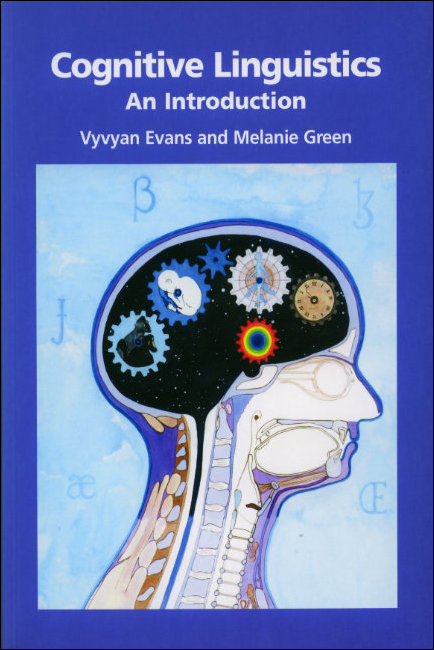
Cognitive Linguistics: An Introduction
作者:Evans, Vyvyan; Green, Melanie
出版社:Edinburgh University Press
Generally speaking, Cognitive Linguistics could be divided into two main fields: cognitive semantics and cognitive grammar. The authors also obey this logic older. In this book, there are 4 parts: 1. introduction; 2. cognitive semantics; 3. cognitive approaches to grammar; and 4. Conclusion.
In the first part, the authors tell us the overview of the cognitive linguistics enterprise, which functions as an introduction to language, linguistics and cognitive linguistics. Besides, in this part, the authors also mention the history of the rising of the cognitive enterprise which is due to the development of the cognitive science in 1950s, and the philosophical foundations of the cognitive linguistics, which makes it become an independent discipline, provides a significant perspective to study language and successfully challenges the linguistic tradition. It is not an exaggeration to say that the rising of cognitive language launches a revolution against Chomsky’s Transformational-Generative grammar. Last, the authors state the main elements in the study of cognitive linguistics. That is to say, different from other approaches to language, this cognitive approach pays more attention to embodied experience and embodied cognition. Surprisingly, the authors have a wide horizon. They are not just limited to the cognitive linguistics itself, but they also focus on the integration of different disciplines, for example, pragmatics, semantics, syntax and psychology.
The second part(cognitive semantics) is one of the main contents of cognitive linguistics just as what I have mentioned above. To begin with, the authors give us the conception or definition of cognitive linguistics through some explanations to let us conceive the framework of this subject in chapter 5 “What is cognitive semantics?”. After having a thorough knowledge of cognitive semantics, the authors begin to illustrate the details of this area, including: chapter 6 embodiment and conceptual structure, chapter 7 the encyclopedic view of meaning, chapter 8 categorization and idealized cognitive models, chapter 9 metaphor and metonymy, chapter 10 word meaning and radial categories, chapter 11 meaning construction and mental spaces, chapter 12 conceptual blending, and chapter 13 cognitive semantics in context. Among those chapters, what attracts me most is the chapter 9 metaphor and metonymy. Before reading this book, like most people, I also hold the idea that metaphor is a linguistic figure which has something to do with literature and can only be used in that field. But after reading the book, I know that it is totally wrong. Metaphors do not just exist in literature works, but everywhere in our lives. Just as Lakoff and Johnson has mentioned in their book: Metaphors We Live By, we often use the concept of war to describe argument. As we all know that war and argument belong to different categories, but we still could understand and interpret the more abstract category argument through the using of the words from the category of war, such as, your words are very aggressive, I’m defending my position, and I win this argument. From those examples, we could find that the word aggressive is used to describe war in the first sentence; in the last two sentence, “defend” and “win” are also the words used in the war. So we could draw the conclusion that metaphors, affected by the social main values and culture, exist in our daily life, lay in our conception system and affect our behavior and thoughts. It is deserved to say that metaphor is an very interesting and hot topic which still has a great deal for us to explore.
The third part(cognitive grammar) is also of the same importance as the second part(cognitive semantics) in the field of cognitive linguistics. The structure of this part is similar to the former part. First, the authors tell us what is cognitive grammar through introducing its sub-branches briefly in chapter 14 “What is a cognitive approach to grammar?”. Then the authors begin to introduce the details of cognitive grammar to show its particular aspects compared with the linguistic tradition. Chapter 15 involves the conceptual basis of grammar; chapter 16-18 introduce the word classes, constructions and tense, aspect, mood and voice respectively;chapter 19 motivating a construction grammar; chapter 20 the architecture of construction grammars, chapter 21 grammaticalization and chapter 22 cognitive approaches to grammar in context. To be honest, this part is more difficult to understand than cognitive semantics, because it not only requires the deep linguistic knowledge, especially the items in syntax and a great command of language. Although cognitive grammar is difficult to understand, the explanations given by the authors are very clear, which is an important reason why I like this book very much.
The last part introduces the direction of the future development of the enterprises of cognitive linguistics and its potentials.
This book includes 4 parts, part 1: Introduction(chapter 1-4); part 2 Cognitive semantics(chapter 5-13); part 3 Cognitive approach to grammar(chapter14-22); and chapter 4 Conclusion(chapter 23).
This book is suitable for undergraduates and postgraduates majoring in foreign languages, especially for students interested in cognitive linguistics and practitioners engaged in cognitive science, such as machine translation.
书评作者:戚佳伟
中国科学院大学外语系
外国语言学及应用语言学专业